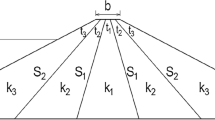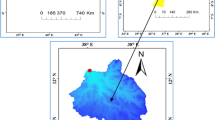Abstract
This paper presents the performance of retention-type earthen dams subjected to steady-state seepage and pseudostatic loading conditions. For this, an earthen dam section having a height of 7.2 m, side slopes of 1H:1V, and a horizontal drain with varying geometry for seepage control is considered. The normalized length (Ld/H) and thickness (td/H) of the horizontal drain (HD) as measured from the toe towards the downstream side varies from Ld/H = 0 (i.e., fully clogged drain) to Ld/H = 1.31 (i.e., up to mid-length of the crest), and td/H = 0 (i.e., fully clogged drain) to td/H = 0.140. The results are presented in terms of variation of phreatic surface, pore-water pressure at a distance of 0.25H from the downstream toe, seepage flux below the crest, and factor of safety (both static and pseudostatic) of the downstream side slope. The earthen dam (having 1H:1V side slopes) filled with maximum upstream water level (hF/H = 0.9) and a fully clogged drain witnessed a factor of safety (FS) less than unity at the downstream side during the static condition (KH = 0) itself. Earthen dams with a fully functional horizontal drain are stable (FS > 1) during steady-state seepage conditions. However, when subjected to inertial (or pseudostatic) loading in the form of horizontal seismic coefficient (KH), the FS values decreased. Further, parametric studies were conducted to understand the influence of side slope inclination on the seepage-stability behavior of retention dams. Furthermore, numerical analyses of retention-type earthen dams were compared and validated with centrifuge tests conducted on earthen dam models (with and without HD) having identical geometrical and material characteristics. The analyses and interpretation of centrifuge test results for retention-type earthen dams subjected to flooding and psuedostatic loading are presented and corroborate well with numerical analysis results.











Similar content being viewed by others
References
Seed HB (1979) Considerations in the earthquake-resistant design of earth and rockfill dams. Géotechnique 29(3):215–263
Foster M, Fell R, Spannagle M (2000) The statistics of embankment dam failures and accidents. Can Geotech J 37(5):1000–1024
Martin TE, Davies MP, Rice S, Higgs T, Lighthall PC (2002) Stewardship of tailings facilities. In: Mining minerals and sustainable development project Report No. 20, International Institute for Environment and Development (IIED), World Businesses Council for Sustainable Development. https://pubs.iied.org/G01027.
Rico M, Benito G, Salgueiro AR, Díez-Herrero A, Pereira HG (2008) Reported tailings dam failures: a review of the European incidents in the worldwide context. J Hazard Mater 152(2):846–852
Owen JR, Kemp D, Lèbre É, Svobodova K, Murillo GP (2020) Catastrophic tailings dam failures and disaster risk disclosure. Int J Disaster Risk Reduct 42(1):1–10
NRLD (2019) National register of large dams. Central dam safety organization, Central Water Commission, Government of India
Saran RK, Viswanadham BVS (2018) Centrifuge model tests on the use of geosynthetic layer as an internal drain in levees. Geotext Geomembr 46(3):257–276
Kumar P, Viswanadham BVS (2022) Design and development of tilt table-based in-flight simulator for pseudostatic loading in a geotechnical centrifuge. Geotech Test J ASTM 45(5):936–960
Singh B, Varshney RS (1995) Engineering for embankment dams. A.A. Balkema, Brookfield, VT
Chahar BR (2004) Determination of length of a horizontal drain in homogeneous earth dams. J Irrig Drain Eng 130(6):530–536
Calamak M, Yilmaz AN, Yanmaz AM (2018) Performance evaluation of internal drains of earthen dams. J Perform Construct Facilit 32(6):1–10
Harr ME (1962) Groundwater and seepage. McGraw Hill, New York
Mishra GC, Singh AK (2005) Seepage through a levee. Int J Geomech 5(1):74–79
Singh AK (2016) Stability analysis of the downstream slope of a levee. Geomech Geoeng 11(2):125–134
Resnick GS, Znidarčić D (1990) Centrifugal modeling of drains for slope stabilization. J Geotech Eng 116(11):1607–1624
IS 9429 (1999) Drainage systems for earth and rockfill dams-code of practice, first revision. Bureau of Indian Standard (BIS), New Delhi, India
Newmark NM (1965) Effects of earthquakes on dams and embankments. Géotechnique 15(2):139–160
Sarma SK (1975) Seismic stability of earth dams and embankments. Géotechnique 25(4):743–761
SVOFFICE5 (2018) SV Slope and SV Flux, Version 5.3, User manual. The Soil Vision Systems Ltd., Saskatoon, Saskatchewan, Canada
Huang YH (2014) Slope stability analysis by the limit equilibrium method. American Society of Civil Engineers, Reston. https://doi.org/10.1061/9780784412886
Duncan JM (1996) State of the art: limit equilibrium and finite-element analysis of slopes. J Geotech Eng 122(7):577–596
Bishop AW (1955) The use of the slip circle in the stability analysis of slopes. Géotechnique 5(1):7–17
Greco VR (1996) Efficient monte carlo technique for locating critical slip surface. J Geotech Eng 122(7):517–525
Siacara AT, Napa-Garcia GF, Beck AT, Futai MM (2020) Reliability analysis of earth dams using direct coupling. J Rock Mech Geotech Eng 12(2):366–380
Morgenstern NR, Price VE (1965) The analysis of the stability of general slip surfaces. Geotechnique 15(1):79–93
IS 7894 (1975) Code of practice for stability analysis of earth dams (Reaffirmed 2002). Bureau of Indian Standard (BIS), New Delhi, India
IS 1893 Part-1 (2016) General provisions and buildings, criteria for earthquake resistant design of structures. Bureau of Indian Standard (BIS), New Delhi, India
IS 1893 (1984) Criteria for earthquake resistant design of structures, Fourth Revision (Reaffirmed 2003). Bureau of Indian Standard (BIS), New Delhi, India
Acknowledgements
The authors would like to express their sincere gratitude to the Board of Research in Nuclear Sciences, Mumbai, India, for supporting the research work under Grant No. 36(2)/15/07/2016-BRNS/36007. The authors also acknowledge the support received from the Centre for Computational Engineering and Science, Department of Civil Engineering, IIT Bombay, Mumbai, India. The authors would like to thank the editor and the reviewers for their suggestions in improving the quality of the manuscript.
Author information
Authors and Affiliations
Corresponding author
Ethics declarations
Conflict of interest
The authors declare that they have no conflict of interest.
Additional information
Publisher's Note
Springer Nature remains neutral with regard to jurisdictional claims in published maps and institutional affiliations.
Rights and permissions
Springer Nature or its licensor holds exclusive rights to this article under a publishing agreement with the author(s) or other rightsholder(s); author self-archiving of the accepted manuscript version of this article is solely governed by the terms of such publishing agreement and applicable law.
About this article
Cite this article
Kumar, P., Viswanadham, B.V.S. Numerical Studies on Seepage-Stability Analysis of Retention-Type Earthen Dams. Indian Geotech J 53, 348–361 (2023). https://doi.org/10.1007/s40098-022-00675-3
Received:
Accepted:
Published:
Issue Date:
DOI: https://doi.org/10.1007/s40098-022-00675-3




